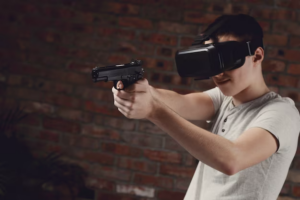Extended reality (XR) holds the potential to dramatically reshape the landscape of the manufacturing industry. By harnessing the capabilities of XR, manufacturing processes can catapult to new heights of innovation and efficiency. The relentless quest for business optimization, across all sectors, invariably draws attention to the versatility and potential rewards of extended reality. Its ability to contribute to the prosperity of businesses, improvement of operational efficiency, and cost-effectiveness is capturing the attention of industry leaders.
The Role of Immersive Technology in Streamlining Operations
As technological advancements continue to gain momentum, many organizations have come to understand the transformative power of immersive technologies in their operations. Such innovations contribute to overcoming challenges such as slow or costly development of products, complex training needs, and more.
Providing real-time insights, advanced training methods, quick problem-solving protocols, and enhanced visualizations, extended reality represents a valuable toolkit for manufacturers seeking to improve their bottom line while ensuring quality and safety.
Extended Reality: Transcending the Entertainment Sector
Previously, technology, particularly XR, was largely perceived as a tool designed for enhancing the entertainment industry. However, the scope for application of XR has expanded tremendously, penetrating diverse industries, with manufacturing at the forefront.
For those immersed in the manufacturing industry, it is a well-known fact that the competition is intense. Companies face immense pressure to produce innovative, safe, and cost-effective products at an accelerated pace, while minimizing waste. In such a scenario, extended reality emerges as a beacon of hope.
Key Ways Extended Reality Can Optimize Manufacturing
- Product Design and Development: XR can create a virtual design of the product, allowing companies to identify any design flaws before production starts, saving both time and money;
- Training: Virtual reality can simulate real-world production line scenarios for training purposes, reducing the risk and cost of training in a live production environment;
- Maintenance and Repair: Augmented reality can highlight problem areas in machinery and provide step-by-step repair instructions, preventing costly breakdowns;
- Quality Assurance: XR technology can help visualize the final product during the production process, ensuring quality standards are met.
Elucidating the Expanding Role of Extended Reality in Manufacturing
The tumultuous era of the COVID-19 pandemic has ushered in a significant shift in the approach to adopting advanced manufacturing technologies. According to the predictive insights of the 2023 State of Manufacturing Report, a whopping 95% of manufacturers asserted that the repercussions of the pandemic would echo in their industry for a prolonged period. This realization gave an unprecedented uplift to the concept of Industry 4.0.
Among the most promising advancements in manufacturing technology, the contributions and potential of Artificial Intelligence (AI), Machine Learning (ML), Robotics, Extended Reality (XR), Data Analytics, and Internet of Things (IoT) development are simply too significant to overlook.
By the dawn of 2023, it is projected that an overwhelming majority of almost 90% of businesses will have substantially ramped up their investments in the realm of digital transformation. Extended Reality (XR) stands as one of the leading options recognized for its remarkable benefits.
Here are the ways XR is shaping the manufacturing sector:
- Revamping Training: XR provides immersive and interactive experiences that can better equip new employees with the necessary skills and knowledge;
- Enhancing Product Design: From conceptualization to execution, XR allows for more efficient and effective product design and development stages;
- Optimizing Maintenance: XR can assist in identifying potential issues before they become serious problems, allowing for predictive maintenance and reduced downtime;
- Improving Quality Control: By offering real-time, 3D visualization, XR significantly enhances inspection processes and quality control standards.
The Rising Influence of Extended Reality in the Manufacturing Realm
Extended reality (XR) was initially touted as the new frontier in entertainment technology. However, it has outgrown its initial scope and emerged as a powerful tool in several industries, not least of which is the manufacturing sector. Progressive manufacturing firms are collaborating with leading XR technology providers like Varjo and Magic Leap, who have crafted exclusive professional solutions using advanced technology.
Through XR, industrial entities can design superior processes to assist their workforce and minimize risks within the manufacturing environment. This transformative technology can expedite product development, streamline time to market, and foster innovative collaborations.
Let’s take a closer look at how XR is being utilized within the manufacturing and industrial sector:
Enhancing Training and Guidance
A typical day for many manufacturing personnel involves operating a plethora of machines. Proficiency in using these technologies safely and efficiently is crucial, and most companies necessitate comprehensive training to equip their workforce.
However, training employees within the manufacturing sector can be a costly and time-consuming affair. Personalized training for handling new machines can disrupt operations and prove expensive. XR comes to the rescue by providing opportunities for uninterrupted, immersive training experiences.
Speeding Up Maintenance and Repairs
In a manufacturing environment, a single glitch can bring an entire production line to a standstill. In such circumstances, swift professional assistance is key to restoring operations. XR can tremendously aid in this respect. Industrial employers can utilize augmented reality (AR) and mixed reality (MR) devices to send high-resolution images of their machinery to remote experts for quick feedback and insights.
Additionally, programs linked to smart glasses can assist staff members in identifying the components that need attention, providing crucial diagrams. With expert guidance instantly available, repairs can be completed faster, sometimes even eliminating the need for physical visits.
Accelerating Product Development
Virtual reality (VR) in the industrial sector offers a collaborative environment where teams can brainstorm product ideas and interact with digital models of machinery. Additionally, it simulates a platform for experimenting with new materials and concepts without the need to create physical prototypes from the ground up. This results in a substantial reduction in transition times between different production stages.
Extended Reality’s Contributions to Manufacturing
Extended reality caters to all four recognized types of learning – visual, written, auditory, and kinesthetic. It fosters deeper intellectual and emotional connections to the subject at hand, leading to more relevant learning experiences. The result is a safer, more realistic work environment where real-world experiences are simulated.

Leveraging Extended Reality for Uninterrupted and Efficient Learning in Manufacturing
Incorporating Extended Reality (XR) in the manufacturing industry is redefining traditional training methods. By immersing learners in the subject matter, XR enhances concentration and engagement, paving the way for effective learning.
Engaging, Sensory-Rich Instruction
The interactive and dynamic three-dimensional structure of XR-based instruction makes learning more visually appealing. Given that over 90% of the information that our brains process is visual, this feature significantly enhances knowledge retention. Studies indicate an 80% improvement in information retention when learners are engaged through visually stimulating and immersive XR experiences.
Practical Training That Ensures Uninterrupted Operations
Previously, training often led to halts in production or removing essential machinery from the line for demonstration purposes. XR eliminates such disruptions. By providing a realistic yet virtual training environment, XR keeps the machinery operative, ensuring that processes keep running smoothly, even while training sessions are underway. This approach not only enhances learning but also boosts overall productivity.
Streamlining Logistics Operations
Extended Reality technologies, including Augmented Reality (AR), Virtual Reality (VR), and Mixed Reality (MR), enable the development of interconnected systems. These systems can accurately locate and guide employees to essential items such as supplies, products, and equipment. This optimizes work processes, reduces waste, and increases efficiency.
For instance, logistics giant DHL leverages smart glasses and mobile devices to help staff locate necessary equipment more swiftly. This has led to a significant reduction in packaging and shipping errors.
Enhancing Data Analysis
In today’s digital age, data analytics is indispensable for a business’s success. Traditional practices involved collecting customer feedback through surveys, questionnaires, and other methods. XR takes this a step further by tracking user behavior throughout their experience using metrics such as eye-tracking, biofeedback, and heart rate monitoring.
Elevating Entertainment with XR: The Convergence of Gaming and Manufacturing
The profound impact of Extended Reality (XR) extends beyond the manufacturing realm, resonating strongly in the world of gaming. While we have discussed how XR revolutionizes manufacturing, it’s equally fascinating to explore how this technology transcends into the realm of gaming, especially with innovations like the “Best VR Gun Controller for Gaming.“
Best VR Gun Controller for Gaming
In the realm of gaming, immersion is paramount. The advent of VR technology has taken gaming experiences to unprecedented levels of realism and engagement. One of the key components in achieving this immersion is the VR gun controller. These devices, such as the renowned “Best VR Gun Controller for Gaming,” bring a new level of interactivity to virtual worlds.
Imagine stepping into a virtual battlefield, feeling the weight of a firearm in your hands, and aiming with precision as you take on opponents in a first-person shooter game. The “Best VR Gun Controller for Gaming” offers precisely that experience. With haptic feedback, realistic recoil, and accurate tracking, it blurs the lines between the virtual and physical, providing an unparalleled sense of presence.
Conclusion
In summation, Extended Reality (XR) holds significant promise for the manufacturing sector, going beyond the realms of product development and training, to include aspects of sustainability and global operations. This technology, which was once confined to the world of gaming and entertainment, is now paving the way for safer, more efficient, and more eco-friendly manufacturing processes. The advent of XR in manufacturing signifies the dawn of an exciting new era, promising a future of continued innovation and growth.


Average Rating